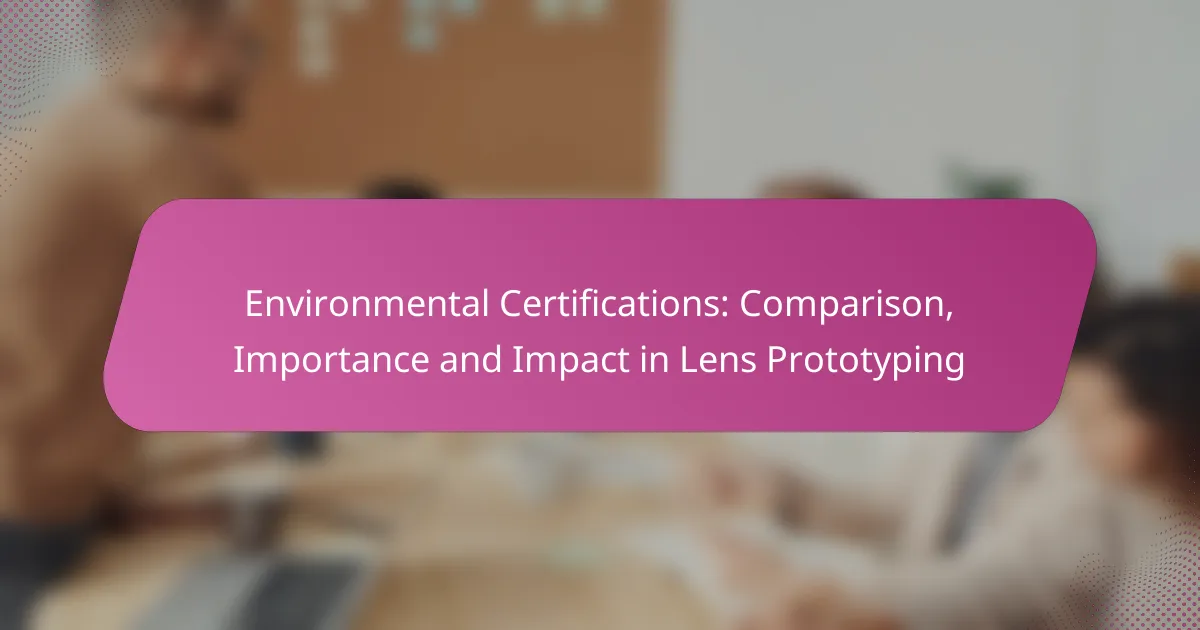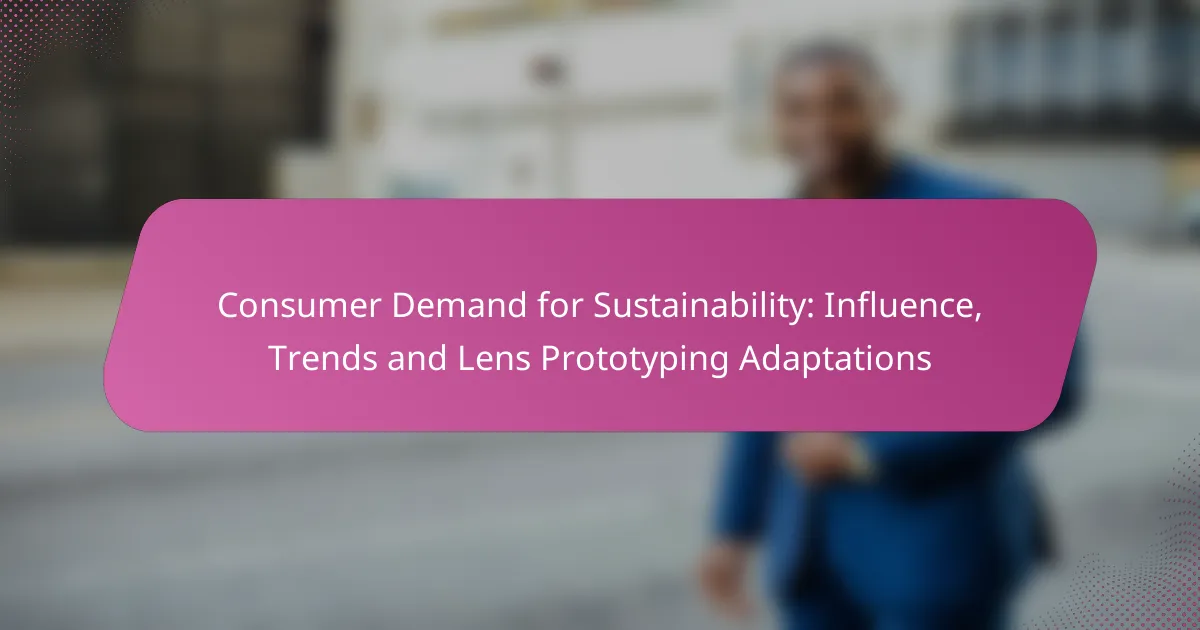How can sustainability be integrated into prototyping?
Sustainability in prototyping can be achieved through the use of eco-friendly materials, innovative technologies, and efficient processes. By focusing on these areas, companies can reduce their environmental impact while maintaining quality and performance.
Use of biodegradable materials
Incorporating biodegradable materials into prototyping helps minimize waste and environmental harm. Materials such as polylactic acid (PLA) and other plant-based polymers decompose naturally, reducing landfill contributions.
When selecting biodegradable options, consider their performance characteristics, such as strength and flexibility, to ensure they meet project requirements. Testing different materials can help find the right balance between sustainability and functionality.
Adoption of 3D printing technologies
3D printing technologies significantly enhance sustainability in prototyping by allowing for on-demand production and reducing material waste. Traditional manufacturing often involves subtractive processes that waste a considerable amount of material, whereas 3D printing builds objects layer by layer, using only the necessary amount of material.
Additionally, 3D printing can utilize recycled materials, further promoting sustainability. Companies should explore local 3D printing services to minimize transportation emissions and support local economies.
Implementation of energy-efficient processes
Energy-efficient processes in prototyping can substantially lower the carbon footprint of production. This includes optimizing machinery settings, using renewable energy sources, and implementing energy management systems to monitor and reduce energy consumption.
For example, switching to LED lighting in production facilities and using energy-efficient equipment can lead to significant savings. Regular audits of energy use can help identify areas for improvement and ensure compliance with sustainability goals.
What are the benefits of sustainable prototyping?
Sustainable prototyping offers numerous advantages, including reduced environmental impact, cost savings, and an enhanced brand reputation. By adopting eco-friendly materials and processes, businesses can create prototypes that align with sustainability goals while also benefiting financially and socially.
Reduced environmental impact
Implementing sustainable prototyping significantly lowers the environmental footprint of product development. This can be achieved through the use of biodegradable materials, energy-efficient manufacturing processes, and waste reduction techniques. For example, using recycled plastics or plant-based materials can minimize reliance on virgin resources.
Additionally, companies can adopt practices such as 3D printing, which often produces less waste compared to traditional manufacturing methods. By focusing on sustainability, businesses contribute to a healthier planet and comply with increasing environmental regulations.
Cost savings in material usage
Sustainable prototyping can lead to substantial cost savings by optimizing material usage. By selecting materials that are both eco-friendly and cost-effective, companies can reduce expenses associated with raw materials. For instance, using additive manufacturing techniques can decrease material waste, translating to lower costs.
Moreover, investing in sustainable practices can lead to long-term savings through improved efficiency and reduced disposal costs. Companies should consider conducting a lifecycle analysis to identify potential savings across different stages of prototyping.
Enhanced brand reputation
Adopting sustainable prototyping practices can significantly enhance a brand’s reputation among consumers and stakeholders. As awareness of environmental issues grows, customers increasingly prefer brands that demonstrate a commitment to sustainability. This can lead to increased customer loyalty and market share.
Furthermore, companies that prioritize sustainability often attract partnerships and investments from like-minded organizations. By promoting eco-friendly practices, businesses can position themselves as leaders in their industry, appealing to a broader audience and differentiating themselves from competitors.
Which materials are best for sustainable prototyping?
Sustainable prototyping materials minimize environmental impact while maintaining functionality. Key options include biodegradable plastics, recycled materials, and natural composites, each offering unique benefits and considerations.
PLA (Polylactic Acid)
PLA is a biodegradable thermoplastic derived from renewable resources like corn starch or sugarcane. It is popular in 3D printing due to its ease of use and low emissions during production.
When using PLA, consider its heat sensitivity; it may deform at temperatures above 60°C. This makes it suitable for prototypes but less ideal for functional parts exposed to high heat.
Recycled plastics
Recycled plastics, such as rPET (recycled polyethylene terephthalate), are made from post-consumer waste, reducing landfill contributions. They provide a sustainable option without sacrificing performance.
When selecting recycled plastics, ensure they meet relevant standards for your application. Look for certifications that indicate the material’s quality and safety for use in prototypes.
Natural fiber composites
Natural fiber composites combine plant fibers, like hemp or flax, with resins to create strong, lightweight materials. These composites are biodegradable and offer a lower carbon footprint compared to traditional plastics.
Consider the specific properties of the fibers used, as they can affect strength and flexibility. Natural fiber composites are ideal for applications where weight savings and environmental impact are priorities.
What technologies support sustainable prototyping?
Sustainable prototyping relies on technologies that minimize waste and energy consumption while maximizing efficiency. Key methods include 3D printing, CNC machining, and virtual prototyping software, each offering unique advantages for eco-friendly design processes.
3D printing
3D printing, or additive manufacturing, creates objects layer by layer from digital models, significantly reducing material waste compared to traditional methods. This technology allows for the use of biodegradable or recyclable materials, making it a sustainable choice for prototyping.
When using 3D printing, consider the type of filament or resin you choose, as some materials have a lower environmental impact than others. For example, PLA (polylactic acid) is derived from renewable resources and is compostable, while ABS (acrylonitrile butadiene styrene) is less eco-friendly.
CNC machining
CNC machining involves the removal of material from a solid block to create parts, which can lead to significant waste if not managed properly. However, advancements in this technology have improved efficiency, allowing for precise cuts and reduced scrap material.
To enhance sustainability in CNC machining, use software that optimizes tool paths and minimizes waste. Additionally, selecting materials that can be recycled or reused can further reduce the environmental footprint of your prototypes.
Virtual prototyping software
Virtual prototyping software enables designers to create and test digital models without the need for physical materials, drastically cutting down on waste. This technology allows for rapid iterations and modifications, leading to more efficient design processes.
When utilizing virtual prototyping, ensure that your software supports realistic simulations to accurately predict performance and identify potential issues early. This approach not only saves resources but also accelerates the development timeline, making it a practical choice for sustainable prototyping.
How does sustainable prototyping impact product lifecycle?
Sustainable prototyping significantly enhances the product lifecycle by promoting durability, recyclability, and waste reduction. This approach not only extends the lifespan of products but also minimizes environmental impact throughout their use and disposal phases.
Longer product lifespan
A longer product lifespan is achieved through the use of high-quality, sustainable materials and design practices that prioritize durability. For instance, products designed with modular components can be easily repaired or upgraded, thus extending their usability. This approach reduces the frequency of replacements, ultimately benefiting both consumers and the environment.
Incorporating sustainable practices, such as using biodegradable materials or energy-efficient manufacturing processes, can also enhance longevity. Consumers increasingly prefer products that last longer, which can lead to higher customer satisfaction and brand loyalty.
Improved recyclability
Improved recyclability is a key benefit of sustainable prototyping, as it allows materials to be repurposed at the end of a product’s life. By designing products with recyclable materials, manufacturers can ensure that components can be easily separated and processed. This not only conserves resources but also reduces the demand for virgin materials.
For example, using materials like aluminum or certain plastics can facilitate recycling processes. Companies can adopt recycling-friendly designs that comply with local regulations, making it easier for consumers to dispose of products responsibly.
Reduced waste generation
Sustainable prototyping contributes to reduced waste generation by minimizing excess materials during production and encouraging efficient use of resources. Techniques such as additive manufacturing can create products layer by layer, significantly reducing scrap material compared to traditional subtractive methods.
Additionally, implementing a circular economy model, where products are designed for reuse and recycling, can further decrease waste. Businesses can adopt strategies to track and manage waste effectively, ensuring that materials are kept in use for as long as possible.
What are the challenges of implementing sustainable prototyping?
Implementing sustainable prototyping presents several challenges that can hinder its adoption. Key issues include higher initial costs, lack of awareness and education, and limited availability of sustainable materials.
Higher initial costs
One of the primary challenges of sustainable prototyping is the higher initial costs associated with eco-friendly materials and technologies. These costs can be significantly greater than traditional prototyping methods, which may deter companies from making the switch.
For example, sustainable materials like biodegradable plastics or recycled metals often come at a premium. Businesses must weigh these upfront expenses against potential long-term savings and environmental benefits.
Lack of awareness and education
Many stakeholders in the prototyping process lack awareness of sustainable practices and their benefits. This gap in knowledge can lead to resistance against adopting new methods or materials, as individuals may not understand the importance of sustainability.
To overcome this challenge, companies should invest in training and educational resources that highlight the advantages of sustainable prototyping. Workshops, seminars, and online courses can help raise awareness and foster a culture of sustainability within organizations.
Limited availability of materials
The availability of sustainable materials can be a significant barrier to implementing eco-friendly prototyping. In many regions, access to high-quality, sustainable options is limited, making it difficult for companies to source the necessary components.
To address this issue, businesses can explore partnerships with suppliers who specialize in sustainable materials or consider local sourcing to reduce transportation impacts. Additionally, investing in research and development can help create new materials that meet sustainability criteria while being readily available.






